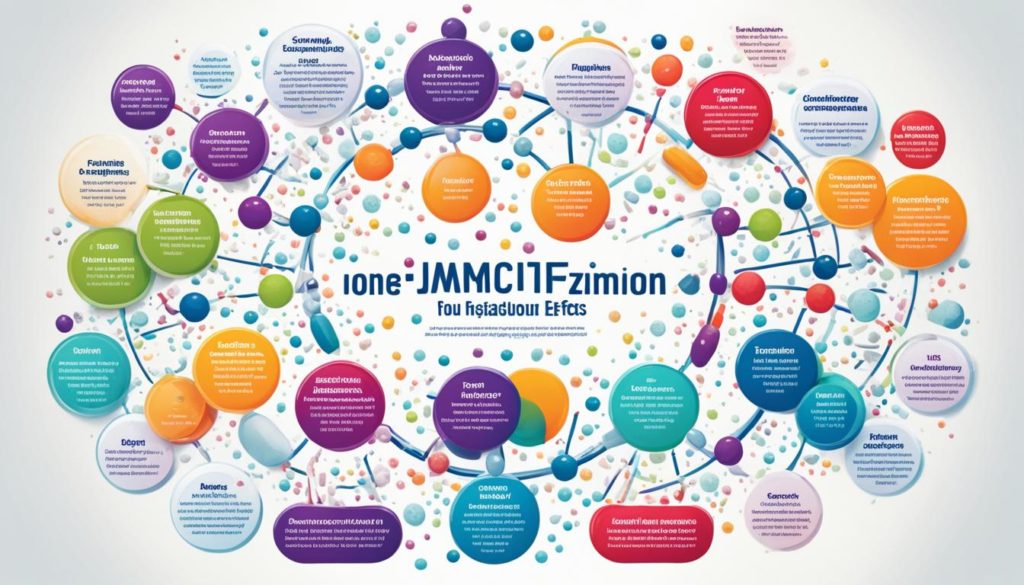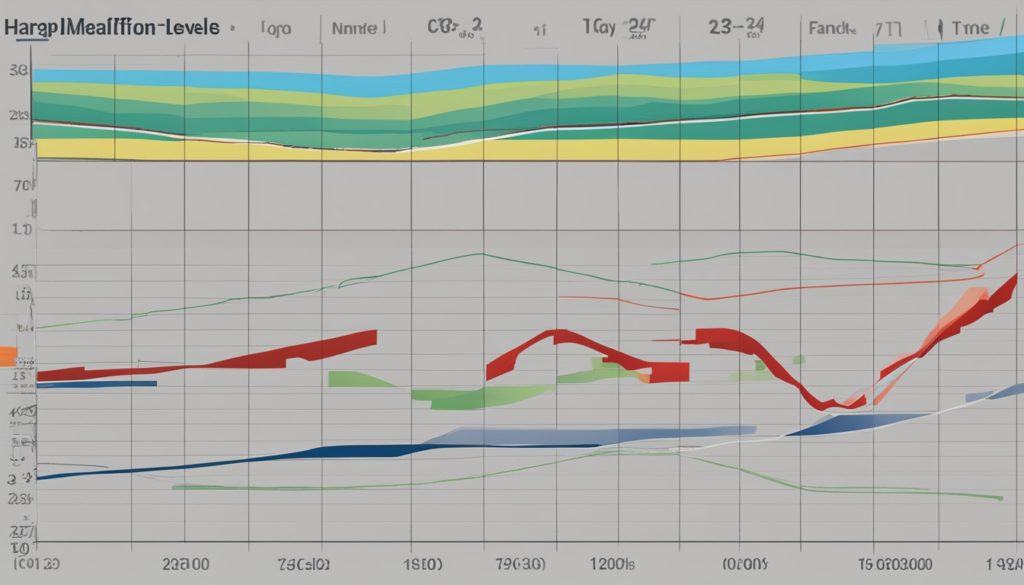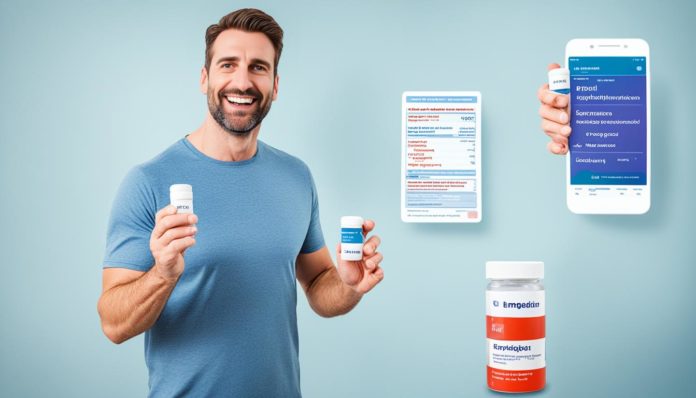Empagliflozin, also known as Jardiance, is a top choice for managing Type 2 diabetes. The FDA has approved it for its role in controlling glucose levels. It also helps with cardiac health and renal benefits. This guide will cover the key benefits and possible side effects of Empagliflozin. It aims to help patients and doctors make better choices for treating Type 2 diabetes. For more details on how Empagliflozin works, keep reading.
Key Takeaways
- Empagliflozin, or Jardiance, is an effective medication for managing Type 2 diabetes.
- It significantly improves glucose control and lowers A1C levels.
- The drug shows beneficial effects on cardiac health by reducing the risk of heart failure.
- Empagliflozin provides long-term renal benefits by protecting kidney function.
- Patients should be aware of potential adverse reactions, including genital and urinary tract infections, and dehydration risks.
What is Empagliflozin (Jardiance)?
Empagliflozin, also known as Jardiance, is a big step forward in managing Type 2 diabetes. This section will cover the basics of Empagliflozin, how it works as an SGLT2 inhibitor, and its FDA approval.
Overview of Empagliflozin
The Empagliflozin introduction is a big deal for diabetes care. It’s an oral medicine meant to help adults with Type 2 diabetes control their blood sugar. Empagliflozin is part of a group called SGLT2 inhibitors. These drugs stop the kidneys from reabsorbing glucose, so it gets passed out in urine instead.

How It Works
The SGLT2 inhibitor mechanism explains how Empagliflozin works. It blocks the SGLT2 proteins in the kidneys. This means less glucose gets reabsorbed, which lowers blood sugar levels. This method is different from other diabetes drugs that focus on making insulin work better or producing more insulin.
FDA Approval and Other Key Information
Empagliflozin got the FDA approved diabetes treatment label after thorough checks. This shows it’s safe and effective for Type 2 diabetes. Clinical trials have shown it helps control blood sugar and lowers heart disease risk. This makes Empagliflozin a key part of managing diabetes today.
| Key Feature | Description |
|---|---|
| Class | SGLT2 Inhibitor |
| Function | Prevents Glucose Reabsorption in Kidneys |
| FDA Approval Date | August 1, 2014 |
| Brand Name | Jardiance |
Benefits of Empagliflozin for Type 2 Diabetes Treatment
Empagliflozin is known for its many benefits for Type 2 diabetes. It helps control blood sugar and more. It’s great for managing Type 2 diabetes because it lowers A1C levels, helps with weight, and reduces heart disease risk.
Improving Glucose Control
Empagliflozin is key for managing Type 2 diabetes. It works by blocking SGLT2 proteins. This means less glucose is absorbed in the kidneys and more is passed out through urine. This lowers blood sugar levels effectively.
Reducing A1C Levels

Empagliflozin is known for lowering A1C levels. Studies show it helps patients control their blood sugar better. This is important for managing Type 2 diabetes and preventing complications.
Impact on Weight and Blood Pressure
Empagliflozin also helps with weight and blood pressure. Patients often lose weight, which is good for their health. It also lowers blood pressure, which helps reduce heart disease risk. These benefits make it a great choice for diabetes care.
Heart Failure Prevention with Empagliflozin
Empagliflozin has shown great promise in helping Type 2 diabetes patients avoid heart failure. It improves heart health and cuts down on hospital stays for heart failure. This makes it a key tool in heart health care.
Mechanism in Heart Failure Patients
Empagliflozin works in several ways to protect the heart. It lowers the strain on the heart by reducing blood pressure and improving heart efficiency. This helps keep the heart muscle safe from harm.
It also helps by cutting down on sodium and glucose in the kidneys. This leads to less blood volume and pressure, which helps prevent heart failure. These actions show how Empagliflozin protects the heart and improves heart health.
Clinical Studies and Evidence
Many studies have shown Empagliflozin is effective in preventing heart failure. The EMPA-REG OUTCOME trial found it lowered the risk of heart failure hospitalization. This study proved Empagliflozin’s benefits for the heart, making it a key part of heart health plans.
The DECLARE-TIMI 58 trial also found it reduced heart failure admissions and deaths. Together, these studies support using Empagliflozin to improve heart health outcomes.
Enhancing Kidney Function with Empagliflozin
Empagliflozin has shown promising effects in enhancing kidney function, especially for those with Type 2 diabetes. It provides significant benefits in keeping the kidneys healthy. This makes it a key part of treating chronic conditions.
Protective Effects on Kidneys
Empagliflozin is known for its kidney protection. Studies show it can slow down kidney damage in Type 2 diabetes patients. It does this by lowering blood sugar and reducing kidney stress. This offers a shield against further kidney function decline.
Long-term Benefits for Kidney Health
The long-term benefits of Empagliflozin for kidney health are many. Regular use helps slow down chronic kidney disease. It also boosts overall kidney function, improving patients’ quality of life over time.
| Aspect | Empagliflozin Benefits |
|---|---|
| Renal Protection | Reduces kidney workload and damage |
| Chronic Kidney Disease Prevention | Slows down disease progression |
| Long-term Renal Health | Maintains kidney function over time |
Most Common Side Effects of Empagliflozin
Empagliflozin is a key medicine for type 2 diabetes. But, users might face some common side effects. Knowing and dealing with these effects helps make treatment better and less uncomfortable.
Genital Infections
One side effect is a higher chance of genital mycotic infections. These happen because high glucose levels in urine help fungi grow. Look out for itching, redness, and odd discharge. Seeing a doctor quickly if you notice these signs is important.
Urinary Tract Infections
Empagliflozin may also raise the risk of urinary complications like UTIs. These infections can make urination painful and cause a strong need to go. Drinking lots of water can help lower this risk. Getting medical help early is key to handling these infections well.
Dehydration Risks
Dehydration is a big issue with Empagliflozin. The drug makes you lose more water by increasing urine production. Drinking enough water is vital to fight dehydration and prevent symptoms like dizziness and dry mouth.
By understanding and managing these Empagliflozin side effects, patients can improve their treatment experience. Regular talks with doctors help keep an eye on and manage these risks well.
Severe Side Effects and Warnings
Managing diabetes means knowing the risks of medications like Empagliflozin. It’s key to understand the dangers and how to prevent them. This includes diabetic ketoacidosis, hypoglycemia, and heart problems.
Ketoacidosis Risk
Diabetic ketoacidosis is a serious issue with high ketone levels in the blood. Empagliflozin can cause this, even if blood sugar isn’t too high. If you have symptoms like nausea, vomiting, or trouble breathing, get medical help right away.
Hypoglycemia Concerns
Empagliflozin helps control blood sugar but can lead to low blood sugar, especially with other meds. It’s important to watch for and manage this. Signs like dizziness or sweating mean you might need to act fast. Learn more about managing low blood sugar here.
Cardiovascular Considerations
Heart health is crucial with Empagliflozin, especially if you have heart issues. Taking precautions and regular check-ups can lower heart risks. Knowing how this drug affects your heart is key to staying healthy.
| Side Effect | Symptoms to Monitor | Action to Take |
|---|---|---|
| Diabetic Ketoacidosis | Nausea, Vomiting, Abdominal Pain | Seek Immediate Medical Attention |
| Hypoglycemia | Dizziness, Sweating, Confusion | Follow Hypoglycemia Management Protocols |
| Cardiovascular Issues | Chest Pain, Shortness of Breath | Consult Cardiologist Regularly |
For more advice and to report side effects, US and Canadian healthcare providers can use this link.
Proper Dosage Instructions for Empagliflozin
Knowing the right Empagliflozin dosage is key for managing diabetes well. Taking the exact dose your doctor says is important. It helps control blood sugar, lowers the chance of problems, and makes sticking to treatment easier.
Standard Dosing Guidelines
Adults usually start with a 10 mg dose of Empagliflozin each day. This is taken in the morning, with or without food. If you need more control, your doctor might increase it to 25 mg a day. Always follow what your doctor tells you for the best results.
- 10 mg daily: The usual starting dose.
- 25 mg daily: This dose is for better blood sugar control.
It’s important to watch how the medicine affects you. Tell your doctor if you notice anything strange.
Adjustments and Special Considerations
Some people might need to change their dosage because of certain health issues or other medicines they take. For example, people with severe kidney problems might not be able to take Empagliflozin.
| Condition | Recommended Action |
|---|---|
| Renal Impairment (Stage 3 or above) | Avoid use or adjust dose based on GFR |
| Concurrent medication changes | Monitor for interactions & adjust dose |
| Severe Hepatic Impairment | Consult physician, possible dosage adjustment |
How well Empagliflozin works can depend on your kidney function. Keeping an eye on this is key to see if you need to change your dosage. Also, it’s important to stick to your treatment plan and talk to your doctor before changing anything.
Comparing Empagliflozin with Other SGLT2 Inhibitors
Choosing the right diabetes medication is important. Empagliflozin, Canagliflozin, and Dapagliflozin are options for managing Type 2 diabetes. Each has its own benefits and might be better for some people.
Empagliflozin, or Jardiance, is great at lowering blood sugar and protecting the heart. But, when looking at alternatives, safety and what’s best for the patient matter too.
Canagliflozin might increase the risk of bone breaks and losing a limb, but Empagliflozin and Dapagliflozin are safer in these areas. This info helps doctors and patients pick the best treatment.
When deciding, think about these things:
- Efficacy: Does the medicine lower A1C levels well?
- Safety: Are there big side effects or risks?
- Patient-specific factors: What health issues might affect the choice of medicine?
Knowing these points helps make a good choice. For more details, check out this health guide.
Here’s a look at the main SGLT2 inhibitors:
| Medication | Brand Name | Key Benefits | Notable Risks |
|---|---|---|---|
| Empagliflozin | Jardiance | Cardioprotective, lowers A1C | Genital infections |
| Canagliflozin | Invokana | Effective in glucose control | Bone fractures, amputations |
| Dapagliflozin | Farxiga | Benefits for heart failure | Dehydration |
In conclusion, looking at SGLT2 inhibitors shows their good and bad points. This helps pick the best treatment for each patient.
Conclusion
This guide has shown how Empagliflozin (Jardiance) helps people with Type 2 diabetes. Studies, like a 24-week clinical trial, prove it can lower blood sugar, help with weight loss, and reduce blood pressure. It’s a strong choice for diabetes care.
Empagliflozin also helps prevent heart failure and keeps kidneys working well. It’s great for patients with heart and kidney issues. This shows its wide health benefits, making it a key treatment option.
But, it’s important to know about possible side effects like genital infections, urinary tract infections, and low blood sugar. When thinking about taking Empagliflozin, talk to your doctor to weigh the risks and benefits. Regular check-ins with your healthcare team are key to handling any side effects well.
In summary, Empagliflozin is a vital medicine for Type 2 diabetes, heart health, and kidney care. This guide aims to give patients and doctors the info they need. It helps make informed choices for the best treatment results.
FAQ
What are the main benefits of Empagliflozin for Type 2 diabetes patients?
Empagliflozin, also known as Jardiance, helps manage Type 2 diabetes in many ways. It improves glucose control and lowers A1C levels. It also helps with cardiovascular and renal health.
How does Empagliflozin work in controlling type 2 diabetes?
Empagliflozin acts as an SGLT2 inhibitor. It stops the kidneys from reabsorbing glucose. This lowers blood sugar levels and helps control diabetes better.
Is Empagliflozin approved by the FDA?
Yes, the FDA has approved Empagliflozin for Type 2 diabetes treatment. It’s also approved for its benefits to the heart and kidneys.
How does Empagliflozin help in preventing heart failure?
Studies show Empagliflozin cuts down on hospital stays for heart failure in Type 2 diabetes patients. It improves heart metabolism and reduces heart load.
Can Empagliflozin improve kidney function?
Yes, Empagliflozin protects kidney function in Type 2 diabetes patients. It slows down chronic kidney disease progression.
What are the common side effects of Empagliflozin?
Side effects include genital infections, urinary tract infections, and dehydration risks. Watch for these symptoms and talk to your doctor if needed.
Are there severe side effects associated with Empagliflozin?
Serious side effects include diabetic ketoacidosis and hypoglycemia. Know these risks and follow your doctor’s advice to manage them.
What is the standard dosage of Empagliflozin?
The usual dose is 10 mg daily. Your doctor may adjust it based on your needs and kidney health. Always follow their advice on dosage.
How does Empagliflozin compare to other SGLT2 inhibitors?
Empagliflozin is one of several SGLT2 inhibitors for Type 2 diabetes. When comparing, look at how effective and safe they are. Also, consider your heart and kidney health.


